In a poll of nearly 100 TMF professionals during a recent Phlexglobal webinar, “Lowering your TMF
Risk Temperature: Real-world Use Cases and Lessons Learned,” more than half of the respondents were concerned that they didn’t have a true picture into the completeness of their Trial Master Files (see Chart 1).
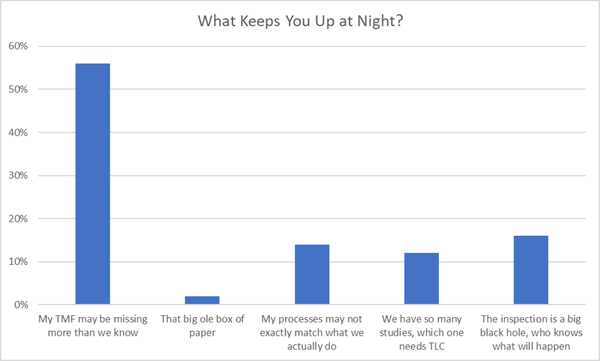 Chart 1. Results from a poll of nearly 100 attendees during the Phlexglobal June 7, 2023 webinar, “Lowering your TMF Risk Temperature: Real-world Use Cases and Lessons Learned.”
Chart 1. Results from a poll of nearly 100 attendees during the Phlexglobal June 7, 2023 webinar, “Lowering your TMF Risk Temperature: Real-world Use Cases and Lessons Learned.”
Frankly, this result was not too surprising to our experts. Why not? While most eTMF systems offer completeness reporting, the reality is that these reports are only as good as the data being entered.
So what can busy study teams do to help ensure they are not missing essential documents? In our experience working with hundreds of customers in similar situations, we’ve found one tool – a TMF heatmaps analysis – to be a quick and cost-effective way to get an accurate completeness picture, regardless of the eTMF system you are using.
During the second of our “TMF Summer Shorts” webinar series, “What are TMF Heatmaps?” on July 26, we took a closer look at the heatmap analysis process and explored how this tool helps study teams ensure TMF health and reduce risk.
What are TMF heatmaps, and how do they work?
TMF heatmaps provide a quick and impartial assessment of where documents may be missing in a single study or across a group of studies (see Figure 1). By evaluating artifact and sub-artifact metadata, heatmaps easily highlight areas requiring a deeper dive into the content and document quality, such as through a TMF Quality Review – enabling a much more efficient risk-based approach to Trial Master File compliance.
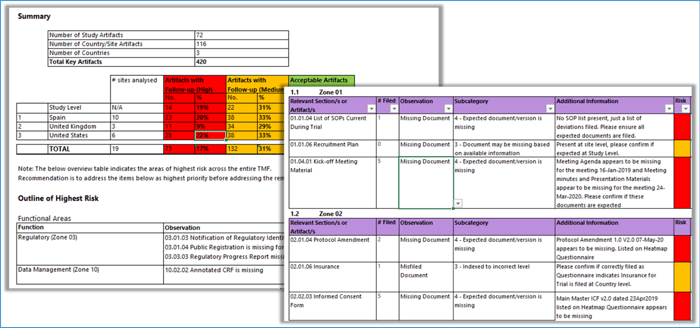 Figure 1. An excerpt from Phlexglobal’s TMF heatmaps analysis, showing an expert assessment of where documents may be missing in a single study or across a group of studies, ranked by criticality and with supporting detail – enabling study teams to focus quality checks and quality review in the most efficient way.
Figure 1. An excerpt from Phlexglobal’s TMF heatmaps analysis, showing an expert assessment of where documents may be missing in a single study or across a group of studies, ranked by criticality and with supporting detail – enabling study teams to focus quality checks and quality review in the most efficient way.
As part of the heatmaps process, teams receive a detailed report with findings, analysis, visualizations, and detailed recommendations at the study, site, and country level. This report includes an expert assessment of relative criticality – i.e., artifact impact and error severity – based on experience with hundreds of inspections (see Figure 2).
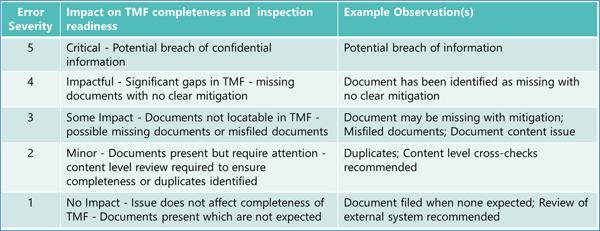 Figure 2. The expert risk scoring provided in Phlexglobal’s TMF heatmaps, shown here, helps focus resources on the areas of greatest impact to TMF risk in a study. It’s also used by companies with multiple studies to help pinpoint recurring problem areas such as a poorly performing CRO or site.
Figure 2. The expert risk scoring provided in Phlexglobal’s TMF heatmaps, shown here, helps focus resources on the areas of greatest impact to TMF risk in a study. It’s also used by companies with multiple studies to help pinpoint recurring problem areas such as a poorly performing CRO or site.
As an example, missing questionnaires will get the lowest risk level. Missing artifacts with the highest impact include items like IRB approvals and safety documents – since issues with these documents can open sponsors to the risk of breaching confidential information or incurring major inspection findings.
When to consider TMF heatmaps
Every company is different, and some may benefit more from heatmaps than others. Even our customers with highly experienced TMF teams and outstanding processes, however, utilize TMF heatmaps as an important part of their risk management approach.
While there is never a wrong time to perform a TMF heatmap analysis, there are common situations where organizations use them to help ensure ongoing quality and inspection-readiness, as shown in Figure 3.
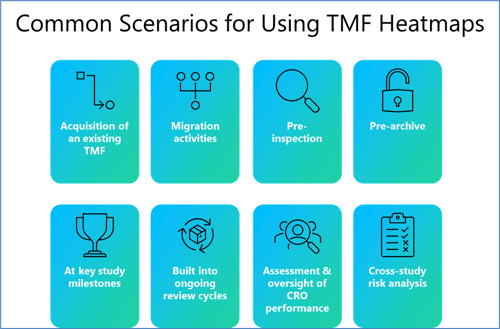 Figure 3. With Phlexglobal’s TMF heatmaps offering a quick and cost-effective way to gauge risk, many of our customers are building heatmap analysis into many or all of the processes shown here as part of a multi-faceted approach to inspection-readiness.
Figure 3. With Phlexglobal’s TMF heatmaps offering a quick and cost-effective way to gauge risk, many of our customers are building heatmap analysis into many or all of the processes shown here as part of a multi-faceted approach to inspection-readiness.
A brief explanation of each scenario:
- Shine a light into acquired products and legacy studies, since the completeness and quality of the TMF is often unknown
- Migrating a Trial Master File, for example from one eTMF system to another, to help ensure the data integrity and quality of the migrated TMF
- Prepare for an upcoming inspection, letting you remediate as time permits but also demonstrating to regulators that you are aware of any gaps and are developing actionable responses to potential findings
- Prior to archiving a study, since inspections can occur even years after the study is closed, making it more difficult to demonstrate GCP as more time has passed.
- Identify high, medium, and low-risk areas when reaching key study milestones, such as site activation, first patient in, database lock, to identify problems before they escalate
- As part of ongoing reviewing cycles to support active TMF management and help ensure inspection-readiness throughout the study
- Provide an impartial performance assessment of service providers such as CROs, identifying quality or process issues that require attention and helping to demonstrate sponsor oversight
- Conduct high-level, cross-portfolio risk analysis to pinpoint common problem areas across studies such as sites / countries not filing documents in a timely manner
There was strong agreement for a number of these scenarios, based on a poll of the 90+ TMF professionals attending the July 26th TMF Summer Shorts webinar, “What are TMF Heatmaps?” (see Chart 2).
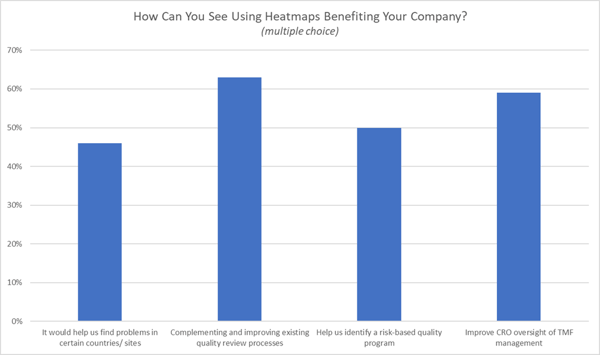 Chart 2. Results from a poll of 90+ attendees of the Phlexglobal TMF Summer Shorts webinar, “What Are TMF Heatmaps?” held July 26, 2023.
Chart 2. Results from a poll of 90+ attendees of the Phlexglobal TMF Summer Shorts webinar, “What Are TMF Heatmaps?” held July 26, 2023.
Sponsor case study: Utilizing heatmaps to proactively drive TMF process improvement
As just one example of how TMF heatmaps can serve as a valuable TMF risk management tool, a Phlexglobal customer has gone from requesting a single heatmap three years ago, to conducting an average of four per month today. Heatmaps now play a key role in their SOPs before conducting TMF quality reviews, and to measure the performance of data teams and the CROs they're working with.
Instead of guessing at the cause of any quality issues with outsourced service providers, for example, the sponsor can point to expert, third-party data to establish the current baseline, problem areas, and remediation plan, and track progress against the plan with actual data.
An additional benefit: The sponsor’s TMF team had struggled getting their study teams to engage with the TMF managers and address the issues noted during any quality oversight activity. We worked closely with them to tailor the heatmap analysis to their requirements and help educate their study teams into the value of the insights provided.
The result? A more collaborative study environment and greater acceptance of the importance of maintaining a high-quality TMF among key stakeholders outside the TMF team.
Want to be sure about TMF completeness? Request an expert TMF heatmap analysis.
Like to learn more? Visit https://www.phlexglobal.com/tmf-heatmaps
.png?width=300&name=PharmaLex_RGB%20(1).png)

